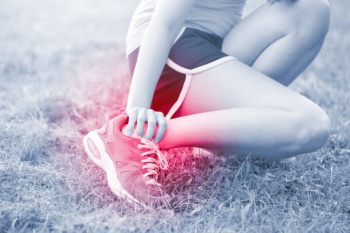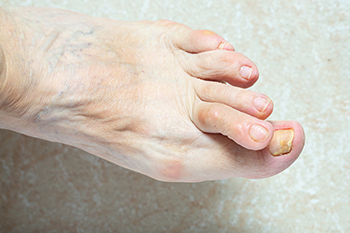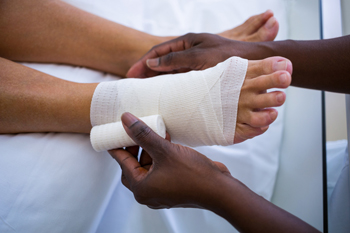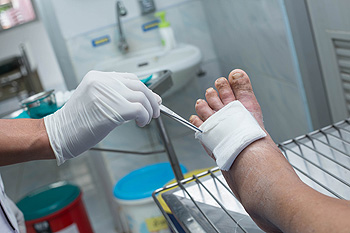Items filtered by date: April 2024
Causes and Symptoms of Achilles Tendonitis

Despite its association with strength, the Achilles tendon is susceptible to injury which can lead to discomfort and impair mobility. Several factors contribute to the development of Achilles tendonitis, including wearing improper footwear, overexertion during activities like speed or mountain running, and insufficient recovery time between training sessions. Other causes can include incorrect loading of weight on the legs or feet, poor running technique, and a lack of proper warm-up exercises. These factors collectively strain this strong tendon, leading to micro-tears in its structure. If left untreated, Achilles tendonitis can progress through various stages of severity. Initially, Achilles tendonitis may cause discomfort during activity or mild pain, which diminishes with rest and conservative measures. However, as the condition progresses, symptoms worsen, with visible changes in the tendon's structure and increased pain levels. Scar tissue formation and a loss of full functionality characterize the advanced stage of this injury. If you are experiencing Achilles tendon pain, it is suggested that you schedule an appointment with a podiatrist for an exam, diagnosis, and treatment options.
Achilles tendon injuries need immediate attention to avoid future complications. If you have any concerns, contact our doctors of Foot & Ankle Center of Oklahoma. Our doctors can provide the care you need to keep you pain-free and on your feet.
What Is the Achilles Tendon?
The Achilles tendon is a tendon that connects the lower leg muscles and calf to the heel of the foot. It is the strongest tendon in the human body and is essential for making movement possible. Because this tendon is such an integral part of the body, any injuries to it can create immense difficulties and should immediately be presented to a doctor.
What Are the Symptoms of an Achilles Tendon Injury?
There are various types of injuries that can affect the Achilles tendon. The two most common injuries are Achilles tendinitis and ruptures of the tendon.
Achilles Tendinitis Symptoms
- Inflammation
- Dull to severe pain
- Increased blood flow to the tendon
- Thickening of the tendon
Rupture Symptoms
- Extreme pain and swelling in the foot
- Total immobility
Treatment and Prevention
Achilles tendon injuries are diagnosed by a thorough physical evaluation, which can include an MRI. Treatment involves rest, physical therapy, and in some cases, surgery. However, various preventative measures can be taken to avoid these injuries, such as:
- Thorough stretching of the tendon before and after exercise
- Strengthening exercises like calf raises, squats, leg curls, leg extensions, leg raises, lunges, and leg presses
If you have any questions please feel free to contact our offices located in Oklahoma City and Yukon, OK . We offer the newest diagnostic tools and technology to treat your foot and ankle needs.
Let the Expert Treat Your Ingrown Toenails
Causes of Overlapping Toes

Overlapping toes, a condition where one toe rests on top of another, affects people of all ages, from newborns to adults. Causes include heredity, tight-fitting shoes, arthritis, and biomechanical issues. Underlying foot conditions, like bunions, flat feet, hammer toes, or high arches, can also contribute to developing overlapping toes. In newborns, this condition may result from heredity or the positioning of the baby in the womb. Gentle measures such as taping the toes or using toe spacers are effective for newborns, while adults can benefit from conservative methods like wearing properly fitting shoes and maintaining a healthy weight. If conservative treatments fail, surgery may be necessary, especially for severe cases or when a bunion is involved. Early intervention is key to preventing long-term complications. For help in managing problems related to overlapping toes, it is suggested that you schedule an appointment with a podiatrist for an accurate diagnosis and treatment options.
Toe pain can disrupt your daily activities. If you have any concerns, contact our doctors of Foot & Ankle Center of Oklahoma. Our doctors can provide the care you need to keep you pain-free and on your feet.
What Causes Toe Pain?
Most severe toe pain is caused due to a sports injury, trauma from dropping something heavy on the toe, or bumping into something rigid. Other problems can develop over time for various reasons.
Toe pain can be caused by one or more ailments. The most common include:
- Trauma
- Sports injury
- Wearing shoes that are too tight
- Arthritis
- Gout
- Corns and calluses
- Hammertoe
- Bunions
- Blisters
- Ingrown toenails
- Sprains
- Fractures (broken bones)
- Dislocations
When to See a Podiatrist
- Severe pain
- Persistent pain that lasts more than a week
- Signs of infection
- Continued swelling
- Pain that prevents walking
Diagnosis
In many cases the cause of toe pain is obvious, but in others, a podiatrist may want to use more advanced methods to determine the problem. These can range from simple visual inspections and sensation tests to X-rays and MRI scans. Prior medical history, family medical history, and any recent physical traumatic events will all be taken into consideration for a proper diagnosis.
Treatment
Treatments for toe pain and injuries vary and may include shoe inserts, padding, taping, medicines, injections, and in some cases, surgery. If you believe that you have broken a toe, please see a podiatrist as soon as possible.
If you have any questions please feel free to contact our offices located in Oklahoma City and Yukon, OK . We offer the newest diagnostic tools and technology to treat your foot and ankle needs.
Venous Ulcer Care
 Venous ulcers are open sores that often occur on lower legs and feet, due to poor blood circulation. Symptoms of venous ulcers include pain, swelling, and discolored or hardened skin around the ulcer. Podiatrists, or foot doctors, can help care for venous ulcers by offering treatments aimed at healing the wound, preventing infection, and improving circulation. This may involve cleaning and dressing the ulcer and prescribing compression therapy to reduce swelling and enhance blood flow. There may also be suggested lifestyle changes, such as regular exercise and elevating the legs to improve circulation. If you are struggling with wounds on the lower legs or feet it is suggested that you make an appointment with a podiatrist to get treatment and prevent future ulcers.
Venous ulcers are open sores that often occur on lower legs and feet, due to poor blood circulation. Symptoms of venous ulcers include pain, swelling, and discolored or hardened skin around the ulcer. Podiatrists, or foot doctors, can help care for venous ulcers by offering treatments aimed at healing the wound, preventing infection, and improving circulation. This may involve cleaning and dressing the ulcer and prescribing compression therapy to reduce swelling and enhance blood flow. There may also be suggested lifestyle changes, such as regular exercise and elevating the legs to improve circulation. If you are struggling with wounds on the lower legs or feet it is suggested that you make an appointment with a podiatrist to get treatment and prevent future ulcers.
Wound care is an important part in dealing with diabetes. If you have diabetes and a foot wound or would like more information about wound care for diabetics, consult with our doctors from Foot & Ankle Center of Oklahoma. Our doctors will assess your condition and provide you with quality foot and ankle treatment.
What Is Wound Care?
Wound care is the practice of taking proper care of a wound. This can range from the smallest to the largest of wounds. While everyone can benefit from proper wound care, it is much more important for diabetics. Diabetics often suffer from poor blood circulation which causes wounds to heal much slower than they would in a non-diabetic.
What Is the Importance of Wound Care?
While it may not seem apparent with small ulcers on the foot, for diabetics, any size ulcer can become infected. Diabetics often also suffer from neuropathy, or nerve loss. This means they might not even feel when they have an ulcer on their foot. If the wound becomes severely infected, amputation may be necessary. Therefore, it is of the upmost importance to properly care for any and all foot wounds.
How to Care for Wounds
The best way to care for foot wounds is to prevent them. For diabetics, this means daily inspections of the feet for any signs of abnormalities or ulcers. It is also recommended to see a podiatrist several times a year for a foot inspection. If you do have an ulcer, run the wound under water to clear dirt from the wound; then apply antibiotic ointment to the wound and cover with a bandage. Bandages should be changed daily and keeping pressure off the wound is smart. It is advised to see a podiatrist, who can keep an eye on it.
If you have any questions, please feel free to contact our offices located in Oklahoma City and Yukon, OK . We offer the newest diagnostic and treatment technologies for all your foot care needs.
Types of Diabetic Foot Ulcers

Diabetes can lead to a variety of foot ulcers, which are wounds and sores that will not heal in a normal time frame. Ischemic ulcers are typically found on the toes and lateral foot areas. They are a result of underlying blood flow problems. Neuroischemic ulcers arise from a combination of diabetic neuropathy and peripheral artery disease, and tend to form at the metatarsal heads. These ulcers present a complex challenge because both damaged nerves and blood vessels are involved. Neuropathic ulcers, a common complication of diabetes, usually begin as callous formations on the bottom of the foot before progressing to ulceration. Patients with severe peripheral neuropathy may exhibit altered gait, skin changes, and reduced sensation, all of which increase the risk of ulcer development. The importance of regular foot exams and proactive foot care in individuals with diabetes cannot be overstated. If you or someone you know is living with diabetes, it is suggested that you schedule an appointment with a podiatrist at the first sign of ulcers on the feet.
Diabetic foot care is important in preventing foot ailments such as ulcers. If you are suffering from diabetes or have any other concerns about your feet, contact our doctors from Foot & Ankle Center of Oklahoma. Our doctors can provide the care you need to keep you pain-free and on your feet.
Diabetic Foot Care
Diabetes affects millions of people every year. The condition can damage blood vessels in many parts of the body, especially the feet. Because of this, taking care of your feet is essential if you have diabetes, and having a podiatrist help monitor your foot health is highly recommended.
The Importance of Caring for Your Feet
- Routinely inspect your feet for bruises or sores.
- Wear socks that fit your feet comfortably.
- Wear comfortable shoes that provide adequate support.
Patients with diabetes should have their doctor monitor their blood levels, as blood sugar levels play such a huge role in diabetic care. Monitoring these levels on a regular basis is highly advised.
It is always best to inform your healthcare professional of any concerns you may have regarding your feet, especially for diabetic patients. Early treatment and routine foot examinations are keys to maintaining proper health, especially because severe complications can arise if proper treatment is not applied.
If you have any questions please feel free to contact our offices located in Oklahoma City and Yukon, OK . We offer the newest diagnostic and treatment technologies for all your foot and ankle needs.
Running Injury Prevention

Preventing foot and ankle running injuries involves a varied approach encompassing various aspects of training and recovery. Strengthening the muscles, especially those in the feet and ankles, can help reduce injuries among runners. Regular strength training exercises, like lunges and squats done three to five times per week, can enhance muscular endurance, coordination, and balance, thereby supporting injury prevention efforts. Allowing adequate recovery time between training sessions is vital for muscle repair and adaptation. Aim for 36 to 48 hours of rest between runs, and gradually increase training volume to avoid overload caused by excessive training. It may not be possible to avoid running injuries, but implementing preventive measures can significantly reduce their likelihood and severity. If you incur a foot or ankle injury while running, it is suggested that you schedule an appointment with a podiatrist for an evaluation and treatment plan.
Exercising your feet regularly with the proper foot wear is a great way to prevent injuries. If you have any concerns about your feet, contact our doctors of Foot & Ankle Center of Oklahoma. Our doctors will treat your foot and ankle needs.
How to Prevent Running Injuries
Many common running injuries are caused by overuse and overtraining. When the back of the kneecap starts wearing out and starts causing pain in your knee, this is commonly referred to as runner’s knee. Runner’s knee is a decrease in strength in your quadriceps and can occur if you’re not wearing properly fitted or supporting shoes. To prevent runner’s knee, focusing on hip strengthening is a good idea, as well as strengthening your quads to keep the kneecaps aligned.
What Are Some Causes of Running Injuries?
- One cause of a common running injury is called iliotibial band syndrome.
- Plantar fasciitis is also another common injury.
- Stress fractures can occur from overtraining, lack of calcium, or even your running style.
Best Ways to Prevent Running Injuries
- Wear footwear that fits properly and suits your running needs.
- Running shoes are the only protective gear that runners have to safeguard them from injury.
- Make a training schedule. Adding strengthening exercises as well as regular stretching can help keep you strong and limber and can lessen the possibility of injuries.
- Stretching keeps muscles limber; this will help you gain better flexibility.
If you have any questions please feel free to contact our offices located in Oklahoma City and Yukon, OK . We offer the newest diagnostic and treatment technologies for all your foot and ankle needs.

